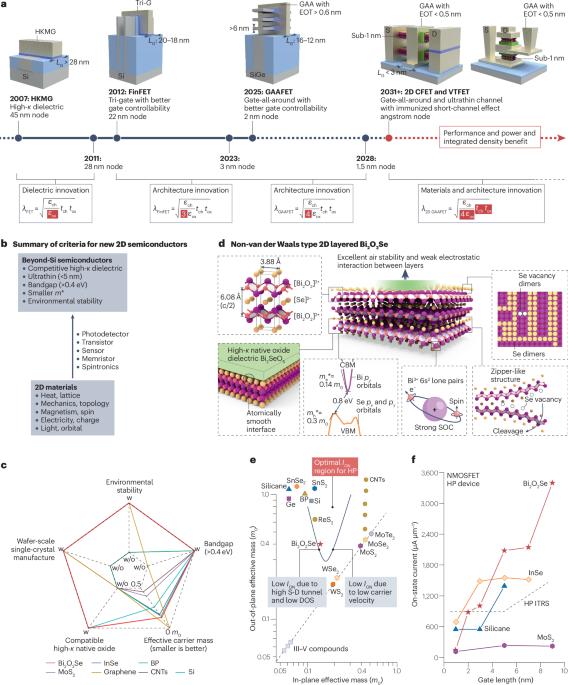2D bismuth oxyselenide semiconductor for future electronics
引用次数: 0
Abstract
The continuous downscaling of silicon transistors has driven exponential improvements in computing performance and energy efficiency, but sub-10 nm channel lengths pose fundamental challenges in speed and power consumption. Emerging materials and architectures offer promising pathways for further miniaturization. Bismuth oxyselenide (Bi2O2Se), an air-stable 2D semiconductor, exhibits high mobility, a suitable bandgap and a native high-κ oxide (Bi2SeO5), resembling silicon and its SiO2 counterpart. These properties suggest compatibility with industrial processes, positioning Bi2O2Se for next-generation high-performance computing. This Review summarizes recent advances in material synthesis, wafer-scale integration and device architectures, highlighting key challenges in the lab-to-fab transition. Finally, a roadmap is proposed to guide future innovations in ultra-scaled, energy-efficient electronics. This Review explores Bi2O2Se as a promising 2D semiconductor for next-generation computing, highlighting its high mobility, suitable bandgap and native high-κ oxide, which enables wafer-scale integration and compatibility with industrial processes, while addressing key challenges in the lab-to-fab transition and proposing a roadmap for ultra-scaled, energy-efficient electronics.

用于未来电子学的二维氧化硒化铋半导体
硅晶体管的不断缩小推动了计算性能和能源效率的指数级提高,但10纳米以下的通道长度在速度和功耗方面构成了根本性的挑战。新兴材料和结构为进一步小型化提供了有希望的途径。氧硒化铋(Bi2O2Se)是一种空气稳定的二维半导体,具有高迁移率、合适的带隙和天然的高κ氧化物(Bi2SeO5),类似于硅和其对应的SiO2。这些特性表明与工业过程的兼容性,使Bi2O2Se定位于下一代高性能计算。本文总结了材料合成、晶圆级集成和器件架构方面的最新进展,强调了从实验室到晶圆厂过渡的关键挑战。最后,提出了一个路线图,以指导未来的超大规模,节能电子产品的创新。本综述探讨了Bi2O2Se作为下一代计算的有前途的2D半导体,突出其高迁移率,合适的带隙和天然高κ氧化物,可实现晶圆级集成和与工业过程的兼容性,同时解决了从实验室到晶圆厂过渡的关键挑战,并提出了超大规模,节能电子产品的路线图。
本文章由计算机程序翻译,如有差异,请以英文原文为准。
求助全文
约1分钟内获得全文
求助全文

 求助内容:
求助内容: 应助结果提醒方式:
应助结果提醒方式:


